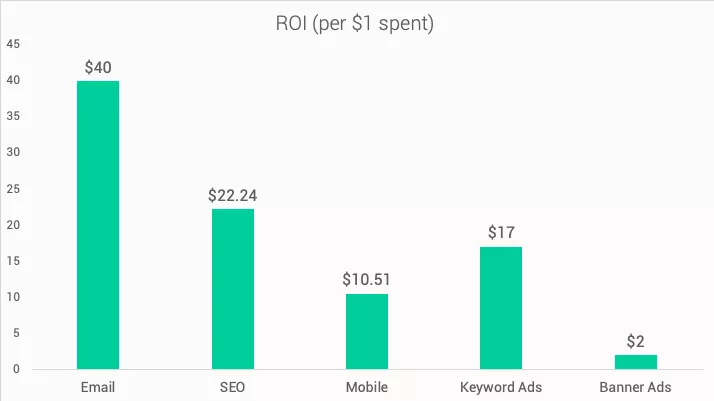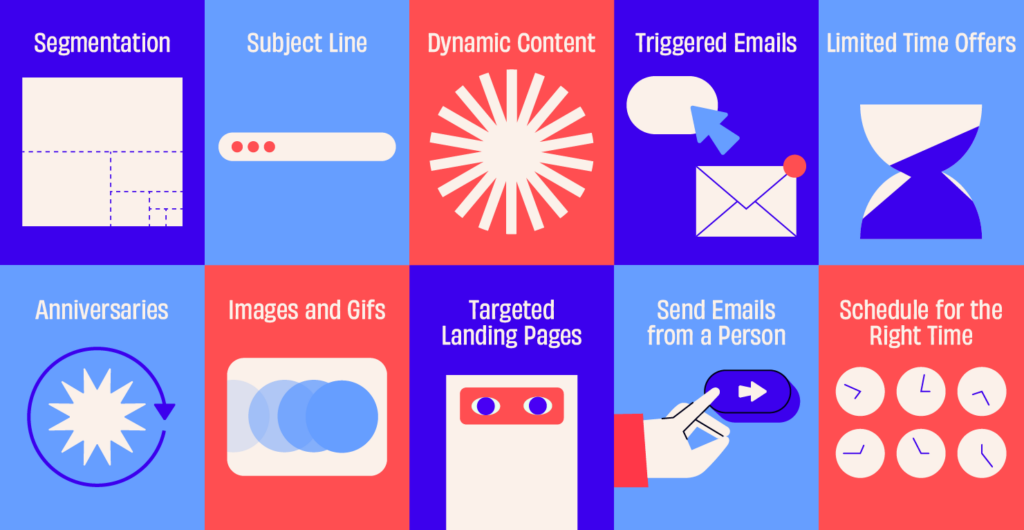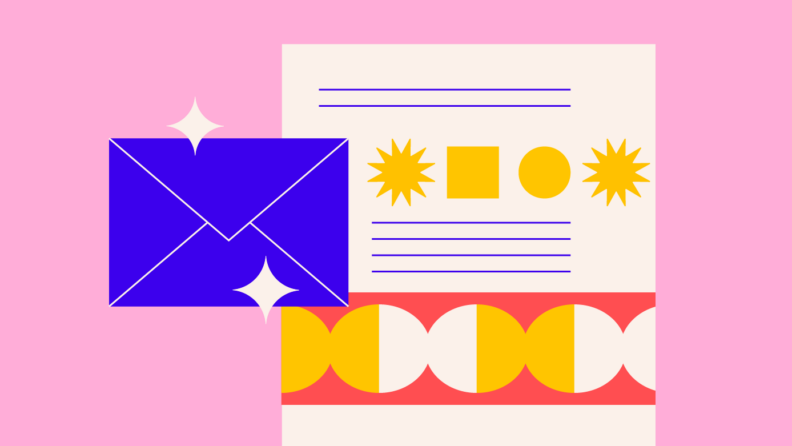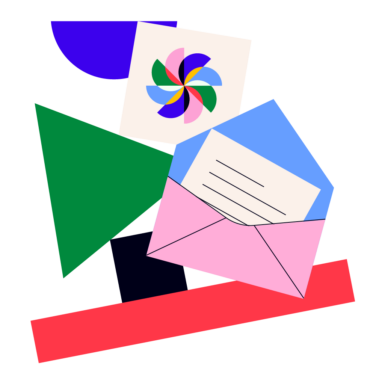According to an Omnisend 2022 report, email marketers make an average conversion ROI of $44 for every $1 spent. That means that every email has the potential to bring in a 4400% profit if it’s properly structured and optimized to perform at its absolute best. Sounds pretty good, doesn’t it?
A Campaign Monitor report also revealed that the open rate of emails with personalized subject lines is 50% higher than others that aren’t personalized. Therefore, we’re going to dig into how you can personalize email marketing for higher opens and clicks, without sounding robotic or creepy, so you can secure that awesome four-figure ROI.

What Is personalized email marketing?
Personalized email marketing is a strategy that allows brands to engage with their audience by writing emails that are uniquely tailored for each recipient. This doesn’t mean writing a different email to each person on your email list–you could, but that’s way too much work. Rather, it involves using already collected data about an individual to write an email that is relevant to them.
We’ll get into the various ways you can do this further down in the article. For now, it’s important to understand how poor email personalization can be the reason why people aren't opening or are even unsubscribing from your mailing list. Since high open and click-through rates hold the promise of high revenue, it’s vital to your business to know how to structure things to make an impact.
the benefits of email personalization
There are a tremendous number of benefits that organizations can track from email personalization. As an extension of that, recipients also get to enjoy the benefits of receiving content that’s more relevant to them. Employing the right email personalization strategy makes it much easier to cut through a cluttered inbox and actually reach your customers. Here’s what you can expect:
Increased open rates:
The average person receives a minimum of 100 work-related emails in a day, and that's before spam and personal emails. To save time (and let's be honest, sanity), people prioritize emails that are relevant or seem to be relevant to them. Personalized emails help to gain the trust of a reader and pique their interest in opening it. People are more likely to ignore generic emails that seem out of touch with them or don’t seem to address their current needs.
Click through rates (CTR):
Once a reader accesses the content of a personalized email, there’s a higher chance that they’ll respond to your call-to-action (CTA) to check up on an offer or view the latest resource. Ultimately, the click through rates on your emails will increase which is beneficial to help drive traffic to your landing page.
Engagement:
Highly personalized emails targeted at an individual’s interests will also draw in the recipient’s attention and get them to engage with your content. This means that you can get them to complete an action on a website, interact with a new website feature, or even check out items in an abandoned cart.
Revenue:
The ultimate goal of email marketing is to ensure that customers take up your offer or check out the new stock on your web store. In the end, the goal is to ensure a high yield in revenue. When your offer addresses the client’s needs and is tailored around their interests, you’re far more likely to cash in and even see repeat customers.
10 Tactics for Email Personalization

If you’ve been getting low open rates for your emails, you’ve likely been lacking proper email personalization. A combination of various techniques typically work best, so let’s get into some of the different ways you can personalize your email marketing for best results, categorized by levels: beginner, intermediate, and advanced.
Beginner Email Personalization Tactics:
Foundational tactics for personalizing emails include:
- Audience Segmentation
- Personalized Subject Lines
- Using a Real Sender Name
- Scheduling for the Right Time
Audience Segmentation
The first thing you want to note is that you’re dealing with actual humans who are all unique and different. It sounds simple, but you’d be surprised by how easily some brands forget this and treat each subscriber exactly the same.
If you want potential customers to prioritize and value your emails, you’ve got to show them how you prioritize and value them in return—and much like personal relationships, that’s done by noticing things. To gather information, track demographics, locations and interests of people visiting your website or your landing page. You may even want to create a form that asks for personal information beyond email addresses if your audience is willing to share.
Having separate lines on the sign-up form for the subscriber’s name helps you segment your email to address your subscribers on a first-name basis when you reach out to them. Go further to collect information about age, gender or special areas of interest they may want to be updated about. This way you’re building a database of information you can work with when crafting your email.
Another way to get enough information for segmentation is to send surveys to your recipients around their interests. This helps you to gather relevant—and oftentimes more precise—information that you could use in building your buyer persona. Interactive emails are also something to consider, as they allow your recipients to indicate their areas of interest based on your preselected choice. An example is one that has readers swipe through or tap on various images.
Personalized Subject Line
At this stage, you’re aware of what makes each segment of your subscriber base unique based on the data you’ve received. To apply this and begin to properly personalize email marketing campaigns, you should start to draft more specific content that aligns with each group’s interest.
Right from the start, your subject line should carry information about something that will be valuable to the reader based on the information received. It could also center around niche-specific information or product recommendations that could help them achieve their current goals faster.
If you're unsure about which subject line works, you can always use an email testing software to run a test and improve your open rate.
Using a Real Sender Name
People would rather binge-watch their favorite shows or spend time on their hobbies than read another minute of an automated mail. However, knowing that the email is from an actual person from your business can make all the difference and improve your email conversion rates.
Your subscribers are more likely to open an email sent by a key person in your organization, particularly when there’s a picture to the name. It could be as simple as ‘X’ from ‘company name’. This feels more personal, knowing that the brand values them enough to find time to write to them, rather than leaving the job to some automation tools. Even better, use a monitored email address where customers can reply to continue the conversation.
Schedule for the Right Time
The last thing anyone wants to do is worry about a new email at family dinner time or just before going to bed. You will need to employ your email data insights to ascertain the best time of day for your subscribers, then schedule the email to deliver at that time. Be sure to pay attention to time zones, too, as you don’t want your email delivered at a different time than you intended. You can use a time-zone calculator to determine the best time to schedule your emails, and segmenting based on location can make things even easier.
Intermediate Email Personalization Tactics
With basic personalization tactics out of the way, you can now move on to more advanced tactics that can take your open rates and click through rates up. Namely:
- Dynamic Content Blocks
- Email Triggers Based on Behaviour
- Using Images or GIFs
Dynamic Content Blocks
When you understand the dynamics around each user’s identity, you can draw from the insights to figure out what their needs or next move could be. This helps you to create highly personalized emails for each segment that’s highly resourceful to them and builds a positive customer experience.
For example, an email campaign to subscribers of an e-commerce site selling mattresses can send emails recommending age-specific mattresses to its audience. A subscriber who identifies as a married person may want ideas on how to purchase beds that simultaneously suit different sleeping preferences, whereas someone with a growing family may want to know when there’s sales on new beds (from twin to double and so on). Insights from your obtained data can go a long way in helping to create valuable email content that’s dynamic.
Employ Triggered Emails
Triggered emails are a great personalization technique for when users interact with a specific feature on your website. As your potential customer progresses through each stage of the buyer journey, you can have targeted emails that reach out to them at different points.
It could be a welcome email on their first sign-up, a ‘thank you’ email on their first purchase, a follow-up email on their visit to your FAQs page, or anything else that shows your client you’re paying attention and that they’re important to you. Many transactional email marketing software have set-it-and-forget-it features that trigger emails based on the customer's behaviour so you don't have to do this manually.
For instance, if a potential buyer started a purchase but didn’t complete the process, a trigger email to prompt them to pick up can yield positive results. Another place where this applies is if you notice that it’s been a while since they interacted with your product or services. You could simply send a ‘we miss you’ trigger email, reminding them that they’re valued by your business.
A trigger email would also be relevant after a subscriber shows interest in attending an event and registers for it. You could follow up with details on how to prepare for the event or how to locate the venue if it’s a physical one. Other examples include exits at shipping costs, abandoning shopping carts, an invitation to membership loyalty, update on personal information, etc.
Use Images and GIFs
Ramp up your email marketing strategy by getting creative and a little more fun. Use of attractive images or Gifs is not only more engaging for your readers, but it can add a touch of humor or personality to your overall brand that may stick with them longer. Animated images are practical ways to hold your reader’s interest as they scan through the email copy to get the juicy highlights.
If you aim to sell a product, a nice image of that product can propel them to buy, as this triggers them to visualize what it would feel like to own it. Before you know it, they could make a spur-of-the-moment decision to purchase an item that they didn’t initially give much thought to.
Be careful not to overdo it, though. Overloading an email with images or GIFs can trigger spam filters or slow down load times, especially on mobile. Some email clients may even strip visuals entirely or display them as attachments, breaking the user experience.
Advanced Email Personalization Tactics
That brings us to the final, and most advanced, email personalization tactics. These are:
- Sending Limited Time Offers
- Acknowledging Milestones
- Targeted Landing Pages
Send Limited Time Offers
Your subscribers are also more likely to respond when they receive limited-time offers, especially on products they’ve previously interacted with or as an upsell to a free resource they've expressed interest in. Generally speaking, people are likely to take action when they know that they’ll be getting something valuable for a fraction of the actual price. That said, the ability to secure the deal at any time could result in a decision-making delay. The best strategy is to make such an offer time-bound, so they know to act fast.
Acknowledge Milestones
As simple as it seems, acknowledging anniversaries or other milestones are a very useful way to personalize your emails to your customers. It shows them that you’re paying attention to their journey with your brand. Acknowledging how long it’s been since their sign up or interaction could bring in an unexpected purchase from an inactive customer.
A birthday anniversary greeting and a special offer to celebrate the day can make a lot of difference for you and your subscriber base. When the communication is less transactional, they soon connect with your brand more personally, which of course is what you want. It also helps to build trust for your brand and gives them the confidence to journey further with you.
Create Targeted Landing Pages
Having targeted landing pages to send your customers to from their personalized emails is a great way to extend the entire personalized experience. After you’ve segmented your subscriber base in terms of their interests, consider which CTA could prove most effective, then design the associated landing page with the preferences that fit that specific audience.
A B2B consulting brand can apply this method by drawing from existing data to determine the best message for anyone needing its services. For example, if they’re speaking with a business under 3 years old they may need a different message from those over 5 years, or 15. Hence the brand’s message has to be uniquely tailored to fit the needs of the businesses.
How to Collect Data for Personalization
Personalized email marketing is only as good as the data behind it. Without reliable, relevant inputs, even the most sophisticated campaigns will miss the mark. Here’s how to collect and manage the right data:
Zero and First-party Data
This is data your audience willingly shares, and it’s gold for personalization.
- Zero-party data: Directly provided by users (e.g. preferences, quiz answers, email sign-up form fields)
- First-party data: Collected through user behavior (e.g. website visits, purchases, email interactions)
Sync your systems to build a single source of truth
Fragmented data leads to fragmented experiences. Connect your:
- CRM (Customer Relationship Management)
- CDP (Customer Data Platform)
- ESP (Email Service Provider)
Avoid the trap of over-collection
Don’t ask for what you don’t need. Collecting birthdays? Great. Collecting pet names, blood type, and mother's maiden name? Hard pass. Respect privacy. It builds trust.
Real-world Examples of Email Personalization
Here’s how top brands are proving that smart personalization is both effective and unforgettable:
Spotify Wrapped
Spotify Wrapped is a great example of personalized email marketing. Each December, Spotify delivers individualized summaries of users' listening habits, including top songs, artists, genres, and total minutes streamed. Insights from user behaviour are presented in a visually engaging format optimized for sharing on social media platforms like Instagram and TikTok.

Spotify Wrapped's shareability turns users into brand ambassadors, amplifying its reach without additional advertising spend. The campaign's viral nature has even inspired other brands to create similar year-end summaries, highlighting its influence in the marketing landscape.
For marketers, Spotify Wrapped exemplifies how leveraging user data to create personalized, shareable content can significantly enhance engagement and brand affinity
Grammarly's Personalized Email Nudges
Grammarly, a writing assistant app, sends personalized emails with usage statistics by analyzing individual user behavior, such as writing habits and activity levels. Grammarly then sends tailored emails that provide insights into users' writing performance. These emails often include statistics like the number of words written, vocabulary usage, and productivity streaks, offering users a personalized overview of their writing progress.

By delivering content that is directly relevant to each user's experience, Grammarly effectively increases user engagement and satisfaction, demonstrating the power of personalized email marketing in the SaaS industry.
Final Takeaway: The Email Personalization Checklist
Before you hit send on your next campaign, run it through this 10-point personalization checklist:
- Know your data sources
- Segment meaningfully
- Personalize beyond the name
- Nail the subject line
- Use dynamic content blocks
- Time it right
- Make it human
- Keep it mobile-first
- Don’t overdo it
- Measure and refine
Ready to hit the ball running with email personalization? Great! We can’t wait to see you increase your open rates, click-through rates and ultimately, revenue. In between, be sure to read more of our articles on email marketing, and don’t forget to check out our resource on the best email marketing software that you could use to gain valuable insights and data.
Oh, and speaking of email, subscribe to our newsletter so you never miss a thing!


